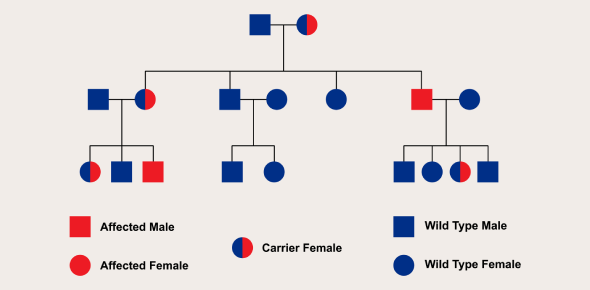Introduction
Pedigree analysis is one of the most powerful tools in genetics. It helps researchers, students, and medical professionals trace the inheritance of traits and disorders across generations. By studying pedigrees, geneticists can identify whether a condition follows dominant, recessive, X-linked, Y-linked, or mitochondrial inheritance.
For students preparing for biology or medical entrance exams, pedigree analysis questions are an important part of the syllabus. These questions test not only the ability to interpret diagrams but also critical reasoning skills in genetics.
In this article, we’ll explore the concept of pedigree analysis, the types of inheritance patterns, strategies to solve pedigree analysis questions, and practice examples with explanations.
What Is Pedigree Analysis?
A pedigree is a diagram that shows the relationships within a family and indicates which individuals display a specific trait. Pedigree analysis involves interpreting these charts to understand how traits or diseases are passed down.
Key symbols in pedigrees include:
- Circle (○): Female
- Square (□): Male
- Shaded symbol: Affected individual
- Unshaded symbol: Unaffected individual
- Half-shaded symbol: Carrier (for recessive/X-linked traits)
- Horizontal line: Marriage/mating
- Vertical line: Children
Pedigree charts help identify inheritance patterns, predict risks, and answer questions about genetic probability.
Importance of Pedigree Analysis Questions
Pedigree analysis questions are frequently asked in exams like:
- NEET (National Eligibility Entrance Test)
- AP Biology
- MCAT
- IB Biology
- University-level genetics courses
They are important because:
- They test logical reasoning instead of rote memorization.
- They combine genetics theory with problem-solving.
- They are useful in real-world applications like genetic counseling.

Types of Inheritance Patterns in Pedigree Questions
1. Autosomal Dominant Inheritance
- Trait appears in every generation.
- Both males and females are equally affected.
- Affected individuals usually have at least one affected parent.
Example: Huntington’s disease.
Clue in questions: If every generation has affected members, think dominant.
2. Autosomal Recessive Inheritance
- Trait may skip generations.
- Both males and females affected equally.
- Parents may be carriers without showing symptoms.
Example: Cystic fibrosis.
Clue in questions: Trait appears suddenly in children, while parents are unaffected.
3. X-Linked Dominant Inheritance
- Both sexes affected, but females may be more common.
- Affected fathers pass the trait to all daughters but no sons.
Example: Fragile X syndrome.
Clue in questions: Daughters always inherit from affected fathers.
4. X-Linked Recessive Inheritance
- More males than females affected.
- Carrier mothers can pass the trait to sons.
- Fathers cannot pass it to sons directly.
Example: Hemophilia, red-green color blindness.
Clue in questions: Trait shows up mostly in males, skipping generations.
5. Y-Linked Inheritance
- Only males affected.
- Passed directly from father to son.
- Never skips generations.
Example: Y-linked infertility.
Clue in questions: Only males show the trait.
6. Mitochondrial Inheritance
- Passed only from mothers to all offspring.
- Fathers never pass it on.
Example: Leber’s hereditary optic neuropathy.
Clue in questions: Trait inherited from mother to all children.
How to Factor a Polynomial: A Complete Guide
How to Approach Pedigree Analysis Questions
When faced with a pedigree question in exams, follow this step-by-step method:
- Check if the trait skips generations.
- If yes, it’s likely recessive.
- If no, it’s likely dominant.
- Compare male vs. female involvement.
- If both equally affected → Autosomal.
- If males mainly affected → X-linked recessive.
- If only males affected → Y-linked.
- Look at father-to-child transmission.
- Father → son transmission = Y-linked.
- Father → daughter only = X-linked dominant.
- Look at mother-to-all-child transmission.
- Suggests mitochondrial inheritance.
- Check for carriers.
- If a parent is unaffected but children show trait → recessive pattern.
By applying these logical steps, you can solve pedigree analysis questions systematically.

Common Pedigree Analysis Questions with Answers
Question 1:
A pedigree shows that the trait is present in every generation. Both males and females are equally affected. What is the mode of inheritance?
Answer: Autosomal dominant.
Question 2:
In a pedigree, unaffected parents have an affected child. Both sexes are equally likely to be affected. What is the inheritance pattern?
Answer: Autosomal recessive.
Question 3:
In a pedigree, an affected father passes the trait to all his daughters but none of his sons. What is the inheritance pattern?
Answer: X-linked dominant.
Question 4:
In a family pedigree, the trait is seen mostly in males. It skips generations, and carrier mothers pass it on to sons. What is the likely inheritance?
Answer: X-linked recessive.
Question 5:
A father with a genetic trait passes it only to his sons. Daughters are never affected. What inheritance pattern does this suggest?
Answer: Y-linked.
Question 6:
In a pedigree, an affected mother passes the trait to all her children, but affected fathers never pass it on. What is the pattern?
Answer: Mitochondrial inheritance.
Tips to Solve Pedigree Questions in Exams
- Look for skipping of generations → Recessive trait.
- Look for gender bias → If males mostly affected, think X-linked.
- Check if all children inherit from mother → Mitochondrial.
- Remember rare traits → Recessive traits are more common than dominant in exam questions.
- Practice with diagrams → Many exams show pedigree charts visually.
Practice Problems for Students
Problem 1:
A pedigree shows affected individuals in generations I, II, and III without skipping. Both sexes equally affected. Predict the inheritance.
Solution: Autosomal dominant.
Problem 2:
Two unaffected parents have two affected children (one male, one female). What is the inheritance pattern?
Solution: Autosomal recessive.
Problem 3:
In a pedigree, all daughters of an affected male are affected, but none of the sons are. What is the pattern?
Solution: X-linked dominant.
Problem 4:
A disease is present only in males. Fathers always pass it on to their sons. Which inheritance pattern is shown?
Solution: Y-linked
Problem 5:
A rare disease is passed from mother to all her children. Fathers with the disease do not pass it on. What is the inheritance?
Solution: Mitochondrial.
Pedigree Analysis Questions in Competitive Exams
In competitive exams like NEET, AP Biology, and IB Biology, pedigree questions often come with diagrams. Some key strategies:
- Quickly identify whether the trait skips generations.
- Count male vs. female affected individuals.
- Apply elimination (e.g., if it’s not Y-linked or mitochondrial, then check autosomal).
- Always remember common genetic disorders associated with each pattern.
Real-World Applications of Pedigree Analysis
- Genetic Counseling – Helps families understand risks of passing disorders.
- Medical Research – Identifies patterns in rare genetic diseases.
- Forensics – Used in family relationship testing.
- Agriculture – Helps breeders study inheritance in animals and plants.
Conclusion
Pedigree analysis questions combine logic, genetics, and critical thinking. By learning the key inheritance patterns—autosomal dominant, autosomal recessive, X-linked dominant, X-linked recessive, Y-linked, and mitochondrial—you can quickly analyze pedigree diagrams and solve exam questions.


